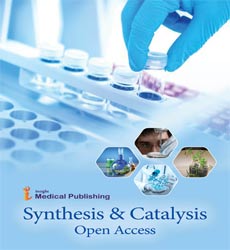ISSN : 2574-0431
Synthesis and Catalysis: Open Access
Recent Development in Green Synthesis
Zaij un Li*
Department of Materials Chemistry, Jiangnan University, China
- *Corresponding Author:
- Zaijun Li
Department of Materials Chemistry
Jiangnan University, China
Tel: +8613912371144
E-mail: zaijunli@jiangnan.edu.cn
Received date: September 20, 2016; Accepted date: September 21, 2016; Published date: September 26, 2016
Citation: Li Z. Recent Development in Green Synthesis. Synth Catal. 2016, 1:1
Copyright: © 2016 Li Z. This is an open-access article distributed under the terms of the Creative Commons Attribution License, which permits unrestricted use, distribution, and reproduction in any medium, provided the original author and source are credited.
Editorial
Sustainable process with a minimal environmental impact is still one of the major challenges in organic synthesis. This strongly requires our chemistry researches to meet the requirements of green chemistry, especially in various chemistry synthesis. According to the requirements of green chemistry, green synthesis is emerging as an important developing direction. Green synthesis often includes the green aspects of synthesis process, including starting materials, catalysts, solvents, reaction temperature and pressure, reactivity selectivity, catalytic reaction or molar reaction, atom economy, toxicity of the starting materials and products, renewable biomass materials rather than fossil materials, nontoxic degradable products. For materials synthesis, the first thing we should pay attention is to design an ideal synthesis route. To choose those raw materials that are environmental friendly is one of most important bases. As starting materials, renewable bio-based chemicals should be employed in place of fossil-based raw materials as much as possible. Keep in mind that these renewable starting materials should be related to the concept of “carbon neutral”, no to increase the carbon dioxide emission. In addition to the bio-based chemicals, environmentally benign reagents, such as water, oxygen from air, hydrogen peroxide, carbon dioxide, etc. are also applicable.
The new reaction medium is another important way for green synthesis. Our group has developed various types of ionic liquids as novel solvents. Due to their favourable properties such as negligible vapour pressure, non-inflammability, reusability, high thermal stability and favourable and easily tuneable physical and chemical properties, ionic liquids technology has been successfully applied to many areas of organic synthesis, bio-catalysis reaction, separation process and electro-chemistry. Specifically, we have published related studies about the applications of ionic liquids in enzymatic synthesis of flavours and fragrances, and enzymatic resolution of secondary alcohol, and as novel solvents in extraction. In addition, one of the main challenges faced in the synthesis is controlling the selectivity, which mainly refers to the method of restraint by-products. Therefore, future synthesis should offer a clean reaction system with producing no or minimal by-products. And above all, we should aim at exploring highly efficient synthetic approaches, which should be of the value in the industrial production.
For catalytic technology, various natural enzymes have been widely used as biological catalysts in many fields because of their high specificity, reaction rate and non-toxicity. However, the inherent weaknesses of enzymes limit their applications in industry. These limitations include fragility, short lifetime, thermal instability, high production costs and difficulty of separation after reaction. To further improve their catalytic behaviour and to decrease the cost, reliable enzyme immobilization with excellent activity is required. Enzyme immobilization can be achieved by simple protein adsorption, by affinity or by covalent coupling. This avoids agglomeration of the active species during chemical reaction and enables an easy catalyst recovery and repeated use. Various carriers provided relativity larger enzyme loading were developed. However, the immobilization process for supports inevitable results in the loss of some enzyme activity. To date, there is still a great need to develop high-performance for enzyme immobilization for ensuring enzyme with high catalytic performance.
Heterogeneous catalysts are supposed to be one of the most promising catalysts to their robustness and operational practicability in the recent years. Among various heterogeneous catalysts, solid bases are of great interest, because they have many advantages over their liquid counterparts. They exhibit great potential for the ease of separation, continuous processing and catalyst recycling. The reactions catalysed by solid base usually show higher selectivity to target product and the formation of tar as a by-product can be hindered. Hence, solid bases offer an environmentally benign and economical pathway for the synthesis of chemicals. Immobilizing homogeneous catalysts to heterogeneous ones also becomes a new direction of this field.
Another research aspect is to develop novel artificial enzymes as replacement to meet the requirements for the further applications. Recently, many efforts have been attempted for the design of Nano catalysts with remarkable catalytic activities and selectivities. Various synthetic strategies of different kinds of nanomaterial including metals, metal oxides, semiconductors, fluorides, etc. with controlled nanostructures have been developed by many research groups. Later studies should improve our understanding of real catalytic processes. Only at that point, will we have a scientific basis for manufacturing nanocatalysts for a broad range of applications in the chemical industry, new-energy resources and pharmacies.
Our group has been researching on the synthesis of nanomaterial and grapheme-based materials and their composites. In addition to the catalytic applications the journal mentioned, we carried out a wide range of studies on the applications of the materials we synthesized in electrocatalysis. And the results demonstrate that grapheme-based materials and metal nanoparticles exhibit excellent electro-catalytic performance. So we think the exploration of high performance of electrochemical is also of great importance.
Open Access Journals
- Aquaculture & Veterinary Science
- Chemistry & Chemical Sciences
- Clinical Sciences
- Engineering
- General Science
- Genetics & Molecular Biology
- Health Care & Nursing
- Immunology & Microbiology
- Materials Science
- Mathematics & Physics
- Medical Sciences
- Neurology & Psychiatry
- Oncology & Cancer Science
- Pharmaceutical Sciences
